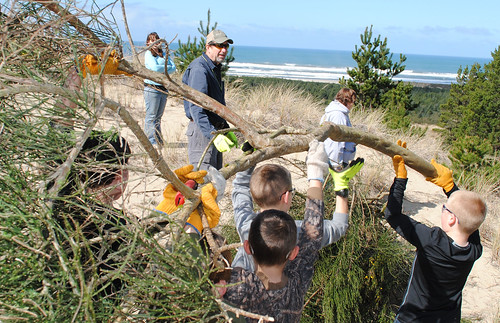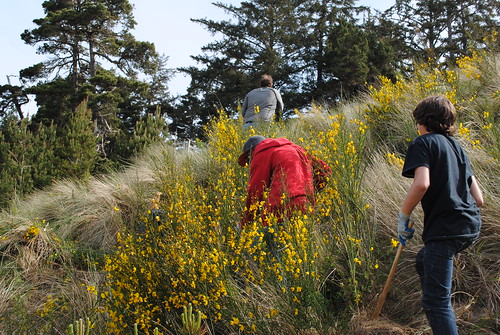
Seventh graders from Siuslaw Middle School recently visited the Oregon Dunes Day Use Area to join the fight against Scotch Broom, one of Oregon’s worst invasive plants.
Armed with gloves, ratchet loppers, and large weed pullers, students freed an open space on the hillside for native plants to re-establish. The seventh graders picked up where Siuslaw Elementary School fourth graders left off in March, and where previous classes have volunteered their time for the last five years.
“These kids can see the difference they’ve made, and that’s something they can have pride in every time they come back here,” said Jim Grano, who heads up the Siuslaw Stream Team that led the restoration project.
The Oregon Dunes are shaped by an intricate balance between life and elemental forces. This process allows diverse ecosystems, such as rainforest, lakes, wetlands and open sand to all thrive in one place. Scotch Broom and European Beach Grass were first planted to stabilize shifting sand in the early 20th Century, and have since become invasive, threatening the long-term survival of the dunes.
The Day Use Area restoration project was organized and led by Grano, Siuslaw Middle School teacher Andy Marohl, and Siuslaw National Forest fisheries biologist Mike Northrop, and supported by SOLV, a non-profit which seeks to build a stronger future for the places Oregonians love.
Grano founded the Siuslaw Stream Team in 1995, and has led projects that link local school groups to ecosystem restoration throughout the Siuslaw Forest and watershed. His programs have an impact both in the environment and in young people’s lives.
For Grano, the connection between schools and restoration work is obvious: “Education is restoration,” he says.
These programs now link Siuslaw students to an ongoing effort of community partners working to preserve the Oregon Dunes, using innovated solutions to fight the threat of invasive species.
Students took breaks from their grueling work to explore the surrounding dunes on guided hikes led by Siuslaw National Forest field rangers. The goal was to connect students to this unique place, and show how they are now part of the dune’s story.
“It’s neat to think about what the dunes might look like in a thousand years,” said one seventh grader, walking over a buried forest where tree tops protrude through sand.

